
If you’re exploring white wines, then Chardonnay and Sauvignon Blanc are an obvious starting point. These two French white wines couldn’t be more different.
Chardonnay is richer with fuller body, while Sauvignon Blanc has medium body, intense fruit, and high acid. Chardonnay offers citrus, apple, peach, and pineapple flavors, while Sauvignon Blanc has gooseberry, passionfruit, and herbaceous notes. Serve both wines chilled; pair with cheese, salads, pasta, meats, and fish.
- Where Is Chardonnay from?
- Where Is Sauvignon Blanc from?
- Chardonnay Wine Flavors
- Sauvignon Blanc Wine Flavors
- Chardonnay vs Sauvignon Blanc: Chart Comparison
- What’s the Difference Between Chardonnay and Sauvignon Blanc?
- Is Chardonnay Sweeter than Sauvignon Blanc?
- Which Is More Expensive: Chardonnay vs Sauvignon Blanc
- What’s the Serving Temperature for Chardonnay and Sauvignon Blanc?
- Sauvignon Blanc vs Chardonnay Alcohol Content
- Chardonnay or Sauvignon Blanc for Cooking?
- Final Thoughts: Chardonnay vs Sauvignon Blanc – Classic or Sassy?
- Thirsty for More?
Where Is Chardonnay from?
Chardonnay is from the Burgundy region of France. Chardonnay enjoys tremendous popularity and today you’ll find Chardonnays made around the world, from France to California, to Australia, and everywhere in between.
Fun Wine Fact: Chardonnay from Burgundy is called White Burgundy. The label might not even have the word “Chardonnay” on it. The producer just assumes you know it’s Chardonnay. Not super helpful for new wine drinkers. Red Burgundy is always Pinot Noir.
Chardonnay adapts to the local environment and does well in both warm and cooler growing conditions. Knowing where your Chardonnay is from will help you pick a wine that you like! Keep reading to find out how.
Fun Wine Fact: Chardonnay is the most popular white wine in the US. Here’s a full post that goes into Chardonnay.
Where Is Sauvignon Blanc from?
Sauvignon Blanc comes from the Loire Valley, France, northwest of Burgundy. This hugely popular white wine grape now grows around the world in all major winegrowing regions, including throughout the US, and perhaps most well-known, New Zealand, where it’s considered the country’s signature wine grape.
Fun Wine Fact: Sauvignon Blanc is one of the parents of Cabernet Sauvignon (the other is Cabernet Franc – a red wine grape). Here’s a full post that goes into Sauvignon Blanc if you’re curious.
Chardonnay Wine Flavors

- Lemon
- Green or Yellow Apple
- Nectarine
- Peach
- Pineapple
- Toast
- Caramel
- Vanilla
- Butter
Helpful Tip: Here’s a 30-second tasting tip to help you identify the fruits and floral notes you’re smelling in white wine.
Winemakers often use oak to age Chardonnay to give the wine toast, caramel, and rich vanilla notes. This can make your Chardonnay taste sweet (even if it’s dry). They also will put the wine through a process called malolactic fermentation – or malolactic conversion – to soften the wine and give it buttery notes and more mouthfeel – meaning it will taste heavier in your mouth.
Helpful Tip: If you’re curious about malolactic fermentation, I put together this slightly nerdy post: Why does my wine taste like butter?
Chardonnay finds itself planted in a diverse range of growing climates, from cool to hot. Chardonnay reflects the growing conditions in its flavor profile.
Cool climate Chardonnay has more citrus, like lemon, lime, and grapefruit, as well as green apples and underripe stone fruits, like white nectarine and peach. Cool climate Chardonnays include:
- Chablis
- Niagra Peninsula
- Petaluma Gap
- Santa Ynez
- Yarra Valley
Warmer climate Chardonnay has ripe, tropical fruit, like pineapple, mango, or even peach jam and lemon curd. Warmer climate Chardonnays include:
- Napa Valley
- California’s Central Valley
- Chile’s Central Valley
Helpful Winebuying Tip: When you’re shopping for a Chardonnay, read the label carefully – look for flavors that point to a cooler or warmer growing climate depending on the Chardonnay wine style you like.
Sauvignon Blanc Wine Flavors
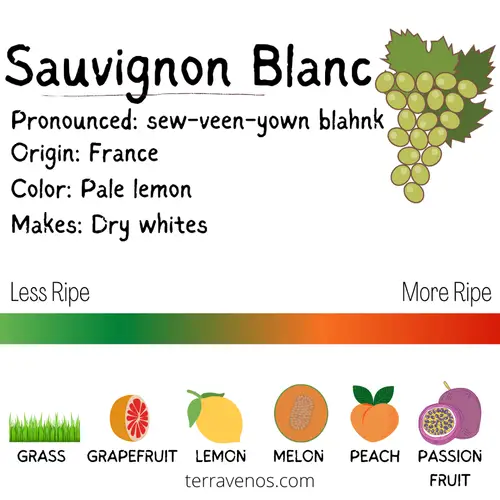
- Gooseberry
- Grapefruit
- Passionfruit
- Grass
- Citrus
Similar to Chardonnay, Sauvignon Blanc grapes grown in warmer or cooler regions will express distinctive fruit flavors.
Warm climate Sauvignon Blanc tends towards tropical flavors, like passionfruit, mango, and pineapple. Cool climate Sauvignon Blanc has herbaceous notes, like grass, hay, and even asparagus.
Fun Wine Fact: A young Sauvignon Blanc from a cool climate may have grassy notes. Those grassy notes will turn into hay if the wine’s aged for a few years.
Like Chardonnay, look for label clues when shopping for Sauvignon Blanc.
If the label mentions passionfruit, it’s likely from a warmer climate. If the label has words like gooseberry, herbs, or citrus, it’s likely from a cooler region.
Cool Climate Sauvignon Blanc Regions:
- Patagonia
- Casablanca
- Petaluma Gap
- Sonoma Coast
- Santa Ynez
- Loire Valley – Sancerre, Pouilly-Fume
- Marlborough
Warm Climate Sauvignon Blanc Regions
- Nelson (New Zealand)
- The Central Valley, California
- Central Valley, Chile
Helpful Tip: Love Sauvignon Blanc? Check out these 8 other white wines like Suavignon Blanc that you should be drinking.
Chardonnay vs Sauvignon Blanc: Chart Comparison
| Characteristics | Chardonnay | Sauvignon Blanc |
|---|---|---|
| Hue | Pale to deep gold | Pale yellow to green |
| Color | White | White |
| Aromas | Apple, pear, vanilla | Citrus, green apple, herbaceous |
| Sweetness | Range from dry to off-dry | Dry |
| Acid | Moderate to low | High |
| Alcohol (%) | 12-15% | 12-14% |
| Body | Medium to full | Light to medium |
| Intensity | Moderate to pronounced | Moderate to pronounced |
| Key Growing Regions | France, USA, Australia | France, New Zealand, California |
| Classic Pairings | Poultry, seafood, creamy dishes | Seafood, salads, goat cheese |
| Price Range | $10-$50 | $10-$30 |
What’s the Difference Between Chardonnay and Sauvignon Blanc?
Chardonnay makes classic rich, creamy, full-bodied white wines with warmth and depth of spice, toast, and butter. Sauvignon Blanc’s style is sassy, and bright, with a punch of fresh fruits that zips through your mouth.
Note: This is the standard distinction between Chardonnay and Sauvignon Blanc. Winemakers can (and do!) play with their grapes and winemaking techniques to craft an infinite number of variations (the infinite variations are why wine people geek out on wine – fun!)
Is Chardonnay Sweeter than Sauvignon Blanc?
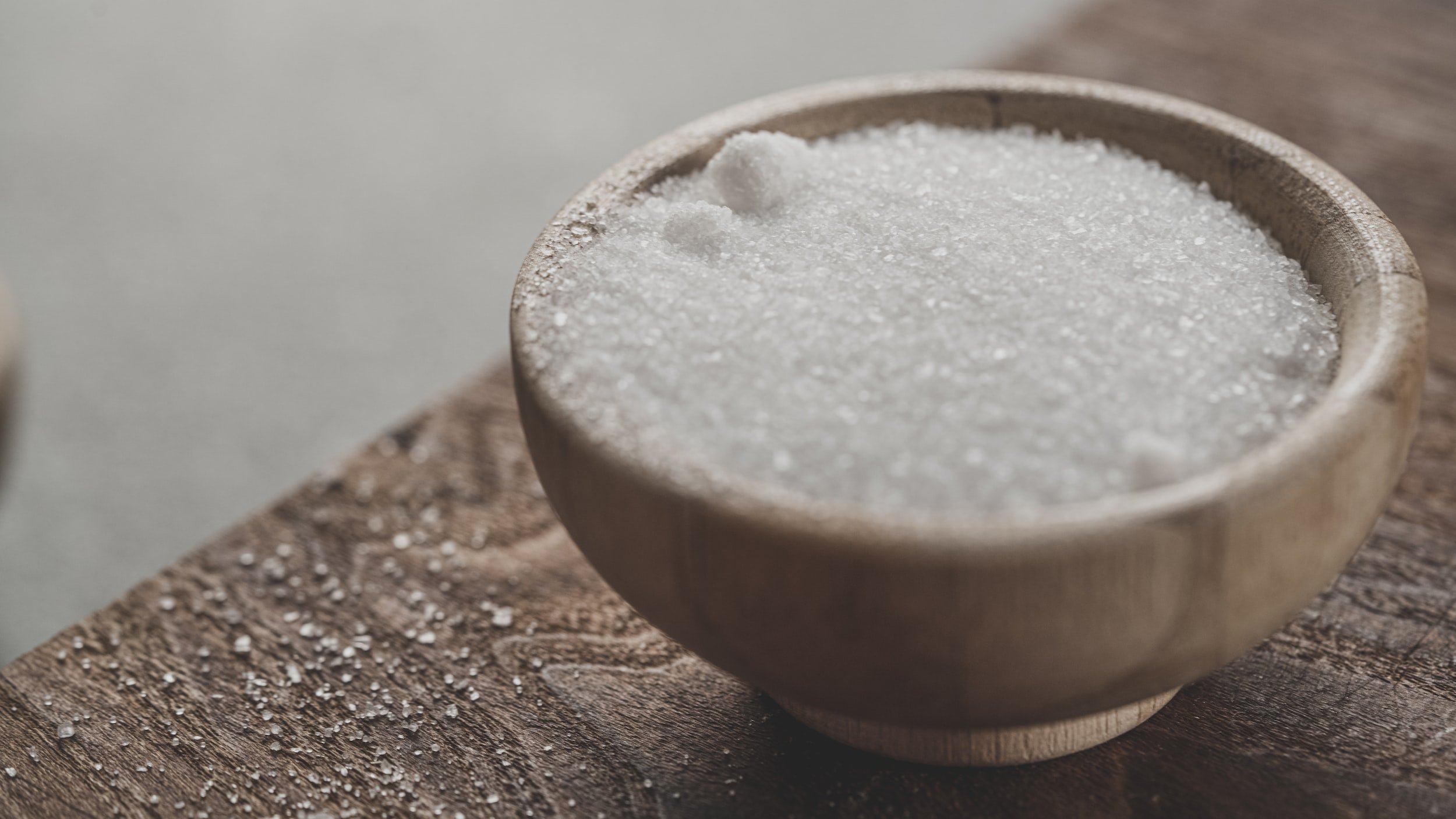
Chardonnay and Sauvignon Blanc are both almost always made into dry white wines. However, if you have a dry Sauvignon Blanc and a dry Chardonnay, the Sauvignon Blanc may taste a bit sweeter thanks to Sauv Blanc’s intense, pure, juicy fruits, which can trick your taste buds into thinking the wine is sweet, even if the wine is dry.
This is one reason why Sauvignon Blanc is so popular.
Helpful Tip: Here’s a full rundown of sweetness in wine that’s useful if you’re trying to figure out if you’re wine’s sweet (or not).
It’s worth noting that sweetness can vary depending on the specific winemaking techniques used, or even the region where the grapes are grown.
Fun Wine Fact: Some Sauvignon Blanc winemakers will add a little bit of sugar (a few grams) back into their wines to help balance out the Sauvignon Blanc’s naturally high acid. It’s likely you can’t taste it (the wine’s just that tart), but it may be there!
Which Is More Expensive: Chardonnay vs Sauvignon Blanc
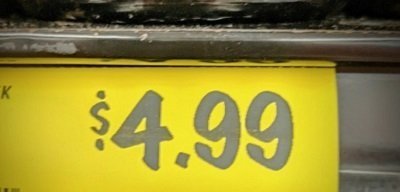
Sauvignon Blanc is less expensive than Chardonnay thanks to fewer winemaking costs, like aging in oak barrels. A 90+ Sauvignon Blanc from the Loire Valley, France will cost around $25+ USD, and you can find many 90+ point Sauvignon Blancs from around the world for under $20 USD. A 90+ Chardonnay from Burgundy, France, starts around $35 USD, but you can find beautiful 90+ Chardonnays from other regions for under $20 USD as well.
Chardonnay and Sauvignon Blanc enjoy tremendous popularity and are made at all price points, from extreme value to ultra-premium – making them both perfect wines for any budget.
Don’t be fooled! Both Chardonnay and Sauvignon Blanc can sell for hundreds, if not thousands, of dollars if made by prestige producers – a sign that both wines are worthy of your attention.
What’s the Serving Temperature for Chardonnay and Sauvignon Blanc?

Both Chardonnay and Sauvignon Blanc are served chilled, but Sauvignon Blanc is generally served at a lower temperature than Chardonnay. Put both wines in your refrigerator the day before you drink them (at least 3 hours before you open the bottle).
- If you’re drinking Chardonnay, take the bottle out 10-15 minutes before pouring.
- If you’re drinking Sauvignon Blanc, take the bottle out, pour yourself a glass, and enjoy immediately.
- If either wine seems closed (not very aromatic), give it a good swirl and let it warm up for 5-10 minutes.
Helpful Tip: To chill or not to chill? This is always a wine question – so I put together this post that goes over what wines to chill and for how long that anyone can use!
Sauvignon Blanc vs Chardonnay Alcohol Content
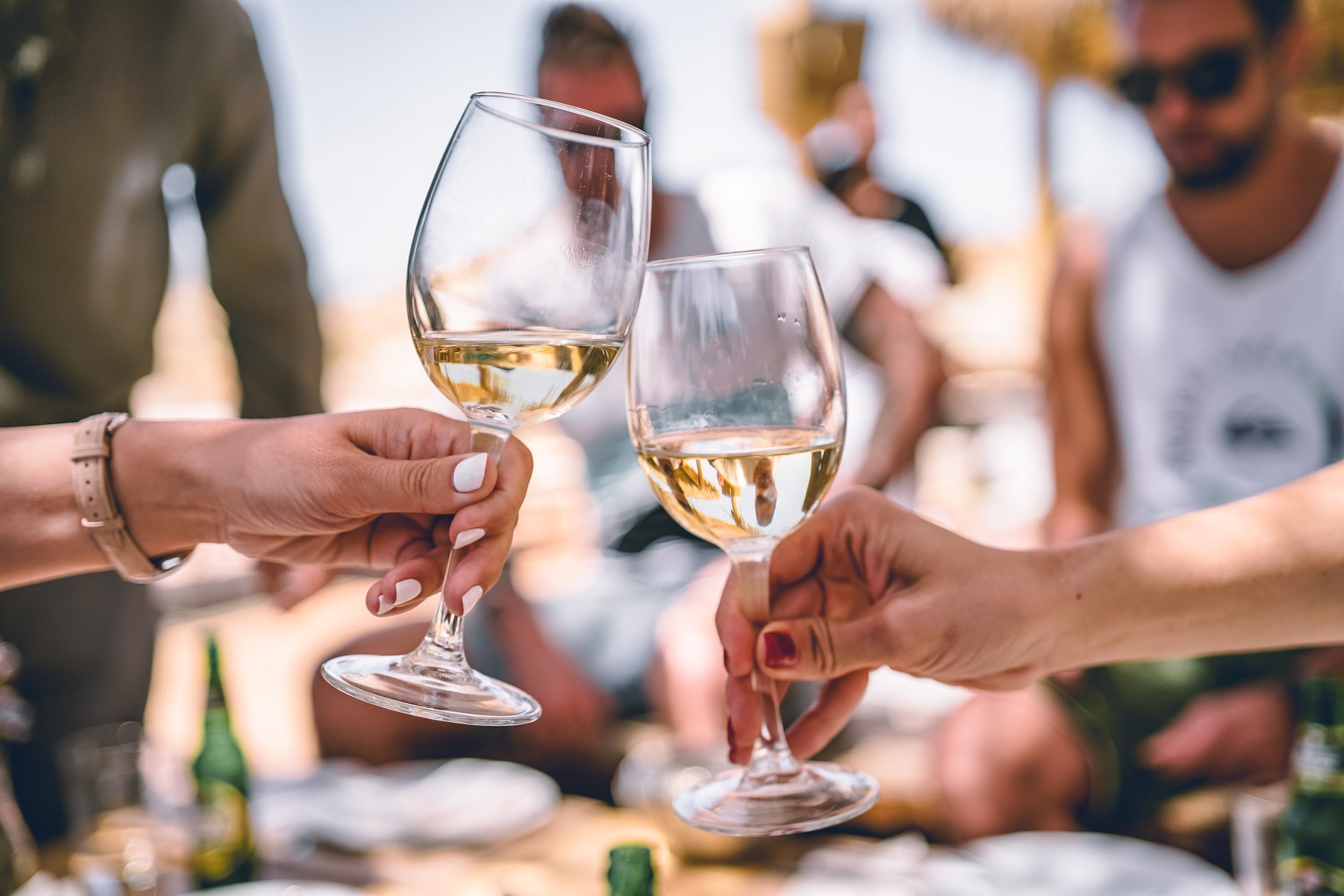
The level of alcohol in Sauvignon Blanc or Chardonnay is directly related to the growing climate. Warmer regions mean riper grapes and more sugar accumulation that can be fermented into alcohol (higher alcohol wines). Almost all Sauvignon Blanc and Chardonnay dry white table wines will have medium alcohol (between 11%-14% ABV).
If you’re concerned about alcohol content, then choose wines that are from cooler growing regions.
Helpful Wine Shopping Tip: Hotter growing climates help grapes accumulate more sugar. More sugar means more alcohol. Higher alcohol wines have more body. So, a high-alcohol Chardonnay (14.6% ABV), will be heavier than a lower-alcohol Sauvignon Blanc (12.5% ABV). Reading wine labels can help you pick out the wine style you want: heavier or lighter?
Chardonnay or Sauvignon Blanc for Cooking?
Both are interchangeable for cooking. Both Chardonnay and Sauvignon Blanc are widely available and made at all price points. So, it comes down to which wine you want to cook with and drink (because you know you’ll be pouring yourself a glass!). Choose the wine you’ll enjoy the most.
Chardonnay Food Pairing Ideas
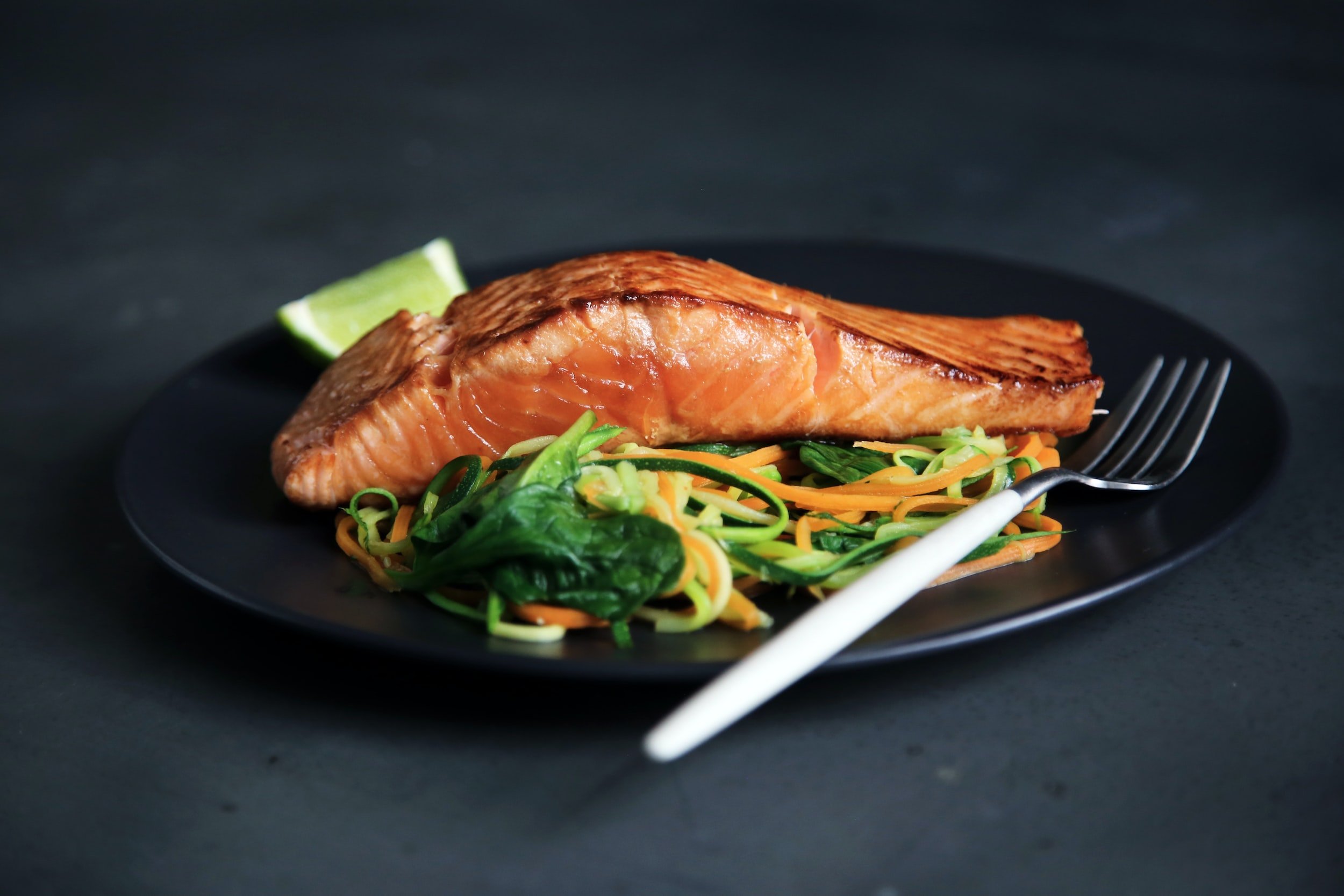
Chardonnay’s classic rich and creamy body lends itself to dishes with more weight, though it works with the same foods as Sauvignon Blanc, too. Think earthy, umami flavors. Here are some ideas to get you started:
- Spaghetti Carbonara
- Beef Stroganoff
- Lentil Soup
- Roasted Carrot Soup
- Grilled Portabello Mushrooms
Side Note: Chardonnay’s a personal favorite. I drink it regularly with great indulgence. Here are my 5-go-to weekday Chardonnay pairings, and this Chardonnay cheese pairing guide.
Sauvignon Blanc Food Pairing Ideas

Sauvignon Blanc’s light and zippy, with that streak of acid lifting up whatever you’re eating. Think about pairing Sauvignon Blanc with foods that call for a dash of vinegar or lemon zest.
- Oysters
- Sushi
- Green Salads
- Noodle Salads
- Anything with a vinaigrette
- Herbed white meats
Final Thoughts: Chardonnay vs Sauvignon Blanc – Classic or Sassy?
If you’re into classic, rich, creamy white wines with warmth and body, then Chardonnay is the wine for you. Sauvignon Blanc wines offer a fruit-forward white wine drinking experience with citrus and zest that tingle in your mouth. If you enjoy light-fruited white wines, then stick with Sauvignon Blanc.
DIY Chardonnay and Sauvignon Blanc Wine Tasting at Home
A great way to get started with these two wines is by doing a side-by-side comparison. Pick up two bottles of similarly-priced wines: 1 bottle of Chardonnay and 1 bottle of Sauvignon Blanc. Pour yourself a glass of each, side-by-side, and taste them slowly.
- Can you smell the difference in the power of the aromas? (Sauvignon Blanc should be more aromatic and jump out of the glass)
- Can you feel the difference in the wine’s acidity? (Sauvignon Blanc should have more acid and make your mouth pucker more than the Chardonnay)
- Can you feel the difference in the wine’s body? (Chardonnay should feel heavier on your tongue compared to Sauvignon Blanc)
- Can you tease out the different fruit flavors?
A side-by-side comparison is the best way to understand the differences between these two beloved wine grapes – and you get to drink wine, so what’s not to like about a little experimentation?
Discover More:
Chardonnay vs Cabernet Sauvignon
Merlot vs Chardonnay
Chardonnay vs Pinot Grigio
Chenin Blanc vs Chardonnay
Sauvignon Blanc vs Pinot Grigio
Thirsty for More?
Here’s a quick post on 5 fun Chardonnay facts if you’re the curious type!
If you’re buying Sauvignon Blanc, chances are very, very good it’s from New Zealand. Here’s a post that explains what’s up with New Zealand Sauv Blanc.
Doing side-by-side tastings, or wine flights, are a fabulous way to learn about wine. So, I wrote a post on wine flights, and what they are, and include 16 ideas for your next wine flight. Go check out wine flights here.




